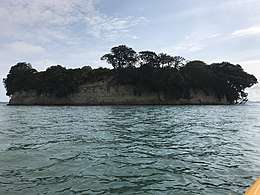Motukaraka Island
Motukaraka Island (Island of Karaka) is a 5.7-hectare (14-acre) uninhabited island 500 m (1,600 ft) off the coast of Beachlands in Auckland, New Zealand with historical significance and a rich history of Māori occupation.
| Nickname: Flat Island | |
|---|---|
 Motukaraka Island taken from the west | |
| Geography | |
| Location | Hauraki Gulf |
| Coordinates | 36°52′41″S 174°58′44″E |
| Area | 5.7 ha (14 acres) |
| Highest elevation | 15 m (49 ft) |
| Administration | |
New Zealand | |
| Demographics | |
| Population | 0 |
The island is flat and approximately 15m above sea level with access from the mainland via a raised shellbank for approximately two hours either side of low tide. The rocks surrounding the island are a popular day trip and fishing destination, although access to the top of the island is difficult due to the steep cliffs around it.
There have been numerous other places named "Motukaraka" throughout New Zealand, including in the Auckland suburb of Green Bay, and in the Hokianga Harbour. Most historical accounts differentiate this island as being 'near Howick'.
History
Historian Percy Smith records that in the late 18th century Motukaraka Island was a heavily fortified pā of about 100 members of the tribe Ngāti Pāoa. Around this time a party from Ngāti Rongo, seeking revenge for a previous attack by Ngāti Pāoa, stormed the island. They cut kauri spars to serve as scaling ladders and attacked the site at dawn. The ensuing massacre wiped out almost all inhabitants, including the Ngāti Pāoa chief Taeiwi. The island has been uninhabited since this time.[1]
Clianthus puniceus, a critically endangered species of plant was recorded as being present on the island in the late 19th century but all expeditions since this time have not discovered the species and it is no longer endemic to the island.[2]
Motukaraka Island was the first historic category scenic reserve in New Zealand, gazetted in March 1905.[3] In the 1920s the island was used for various farming purposes, including growing karaka, breeding rabbits and farming potatoes, with a chute built to drop the bags of potatoes down unto waiting carts.[4] Although the island was used for farming it was not inhabited or settled.
In 1965 a fire broke out on the island and burned unchecked for three days. All plants except a few coastal pohutukawa were destroyed in the fire.[5]
It has also been known variously as Flat Island[5], Motu Ika (Fish Island)[6], and Reserve Island.[7]
Conservation and recreational use
.jpg)
Many expeditions in the 1990s and 2000s have taken place to study the recolonized flora and fauna and remove pests.[8][9] Pest eradication appears to have been successful but the loss of the mature plants and trees in the fire has facilitated the growth of weeds.[5]
At various times stairs have been present to allow easy access to the island but drainage issues and the harsh environment have required their removal.[5] Despite this the island is a popular walk and fishing area.[10]
References
- Monin, Paul (December 1996). Waitangi Tribunal for the claim Wai 406 (PDF). Waitangi Tribunal. p. 20. Archived from the original (PDF) on 9 December 2019. Retrieved 9 December 2019.
- "Transactions and Proceedings of the Royal Society of New Zealand 1868-1961". National Library of NZ. Archived from the original on 13 February 2019. Retrieved 9 December 2019.
- "Picking the places:the Commission 1904–06" (PDF). Dept of Conservation. NZ Government. p. 34. Archived from the original (PDF) on 5 February 2019. Retrieved 9 December 2019.
- "Beachland History". Pohutukawa Coast. Archived from the original on 24 February 2018.
- Russell, James (2006). "Ecological Survey of Motukaraka (Flat Island), Beachlands, Auckland" (PDF). Journal of the Auckland Botanical Society. 61 (1): 57–61. Archived from the original (PDF) on 17 February 2013. Retrieved 9 December 2019.
- "Paparoa, Owairoa or Howick name?". Howick and Pakuranga Times. Archived from the original on 1 May 2018. Retrieved 9 December 2019.
- "North Island: Auckland, 1920". Kura. Retrieved 9 December 2019.
- Cameron, EK. "Motukaraka Beachlands trip observations" (PDF). Retrieved 9 December 2019.
- Beever, Jessica. "Mosses of Motukaraka (Flat Island)" (PDF). Retrieved 9 December 2019.
- Chamerlin, Stephanie. "Motukaraka: An island treasure". NZ Herald. Archived from the original on 7 January 2014. Retrieved 9 December 2019.